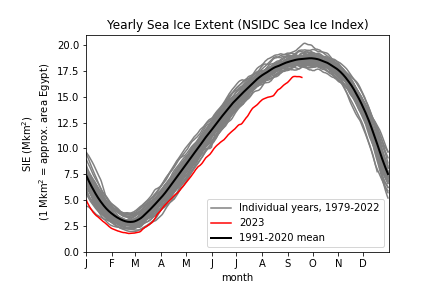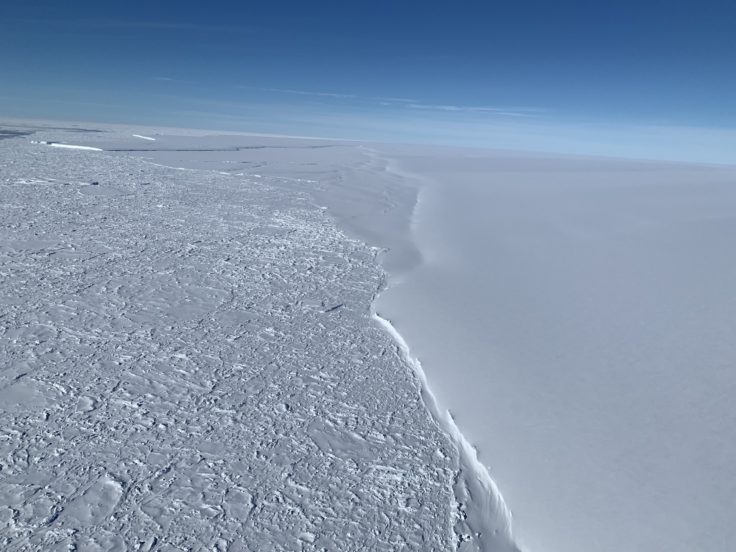Sea ice in Antarctica has been in the news recently – and not in a good way. The National Snow and Ice Data Centre (NSIDC) announced that the winter sea ice around Antarctica has reached a record low.
Here scientists Dr Caroline Holmes and Dr Jeremy Wilkinson, sea ice experts at British Antarctic Survey, describe what’s going on, why sea ice around Antarctica is important, and why a record low is concerning to the scientific community.
 |
Dr Caroline Holmes, Climate scientist Caroline’s research seeks to understand how the current climate models used in climate change assessments simulates sea ice, and how this affects our future projections of climate change. |
|
 |
Dr Jeremy Wilkinson, Sea ice physicist Jeremy is an expert on sea ice dynamics, thermodynamics and mechanics, ocean wave propagation through sea ice, and deep-convection and water mass modification. |
In the polar oceans, it gets so cold that the sea surface freezes. In these ice-covered waters a vibrant ecosystem has evolved to thrive in this unique environment. But beyond being a home to many iconic species that live nowhere else on our planet, sea ice has important physical properties.
It limits the transfer of heat, momentum and gases (such as carbon dioxide) between the ocean and atmosphere. In turn, its annual growth and melt influences global ocean circulation. But perhaps the most important climate-related property is simply that it is white, and so it reflects almost 80% of incoming sunlight back into space. On the other hand, if the sunlight hits the ocean, the ocean absorbs most of the sun’s energy, and only 20% is reflected back into space. So the less sea ice there is the warmer the polar oceans, and hence our world, becomes. This is bad news. Recently, there has been a dramatic loss of sea ice around Antarctica, so what is going on?
What we know
Antarctic sea ice grows outward from the continent in the Southern Hemisphere winter, reaching a maximum extent in September or October. During the summer months it melts back towards the shore, reaching a minimum in February or March. This waxing and waning of Antarctic sea ice is one of the greatest seasonal changes on the planet.
Since October 1978, special sensors that can see through the cloud cover and polar night have been mapping the daily sea ice extent from a series of satellites. The resultant data now provide an unbroken record of daily sea ice extent spanning 45 years. It is the analysis of this unbroken record that enables scientists to chart the seasonal freeze and melt cycle, analyse relationships with the ocean and atmosphere, and identify changes.

These observations of Antarctic sea ice have thrown up several enigmas that have had scientists scratching their heads. In the early years of the 21st century, Antarctic sea ice seemed resilient to a warmer world. Rather than decreasing in extent as the Arctic sea ice did and as climate models simulated, it stayed relatively stable, even slightly increasing. In fact, between 2006 and 2015 Antarctic sea ice extent repeatedly experienced record high values, perplexing many scientists.
But recently events have transpired that suggest Antarctic sea ice may not be so resilient after all. From 2015, a rapid transition took place, with the record highs giving way to a record low summer minimum sea ice extent in February 2017. A modest recovery followed, until further dramatic reductions led to new record summer minima in both 2022 and 2023.
However, winter sea ice stayed somewhat resilient until this year: 2023. As freeze-up began, sea ice was already at low levels – but nothing hinted at what was to come. The slowest freeze up ever observed led to the largest negative anomaly in the satellite record, and to a record low winter ice cover which was 10% below the long-term average.
This series of extreme, record lows over several years have not been seen before, and as a result, scientists are asking if Antarctic sea ice has entered a new regime – one where sea ice is less resilient and covers a decreasing area of the Southern Ocean.
In the context of a warming atmosphere and ocean, driven by burning of fossil fuels, it is tempting to immediately attribute the dramatic change to human-induced global warming. However, Antarctic sea ice is highly variable and the drivers of this variability are complex, as sea ice is known to be highly susceptible to change in both the atmosphere and ocean. Understanding how these human and natural factors combine is crucial to improving our predictions for the future.

What could be causing it?
While the exact causes of recent lows will take years to decipher, existing knowledge of how winds and ocean temperatures normally impact sea ice can offer some clues.
The pattern of winds around Antarctica drive many year-to-year changes in sea ice. Particularly important in West Antarctica is a low pressure system of varying strength and position, known as the Amundsen Sea Low (ASL). For the past several years and into winter 2023 the pressure here was particularly low, consistent with very little ice in the Bellingshausen Sea and more in the Amundsen Sea. However, in July 2023, this pressure pattern decayed, and by the end of winter sea ice accordingly returned to near-average in the Bellingshausen Sea.
At a continental scale, an atmospheric pattern that drives sea ice variability all around the continent is the Southern Annular Mode (SAM). This is the difference in atmospheric pressure between mid-latitudes and the pole, and therefore the strength of the winds that surround Antarctica. Scientific studies of past observations have revealed that a positive SAM normally favours a larger extent of sea ice, and a negative SAM links to a lower sea ice extent. This presents a puzzle: the recent record lows have occurred despite a positive SAM.
This contradiction has led scientists to turn their attention away from atmospheric factors, to changes that are occurring in the ocean. A recent study by an Australian team has highlighted warming in the top 200m of the ocean. It doesn’t just coincide with the dramatic sea ice loss, but slightly precedes it, pointing to the role of this buildup of heat in the sea ice loss. A warmer ocean inhibits ice formation, and once formed it is thinner at the end of winter and so melts earlier.
Wind patterns can be affected by climate change, but are generally hard to attribute, whereas ‘thermodynamic’ changes (directly temperature linked) are easier to attribute. So, the ocean warming could be a clue to a climate change driver.
Antarctic sea ice is part of global systems
Understanding the system as a whole – the ocean and atmosphere together – should provide real insight into the underlying drivers, and the role of human induced warming in the dramatic loss of Antarctic sea ice.
Evidence of sea ice extent from early satellite sensors and 20th century sea ice reconstructions suggests that there is a lot we don’t understand about how sea ice varies naturally on long timescales (longer than the 45 years of the satellite record). But even if there is a big natural component to what’s just happened, it’s happened in the context of a warmer ocean and a warmer atmosphere. Crucially, this makes recovery of the ice cover more unlikely.
Usually, we’d look to climate models for both ‘attribution studies’ – that is, an understanding of what has caused the current event and how likely it would be without increased carbon dioxide – and for future projections. But the IPCC has stated low confidence in the ability of current climate models to simulate the Southern Ocean and its sea ice. This is one reason why studies of their projections of future changes in sea ice lag behind those for the Arctic, and why work is urgently needed to reduce uncertainties in these projections.
One sign that our models need improvement is that they predicted Antarctic sea ice extent should reduce in response to rising CO2 levels – but, as noted above, it was not until 2017 that a dramatic reduction in the sea ice extent occurred. There’s lots of possible reasons for that delay, but we are thwarted by a lack of observational data. In particular we need integrated, multidisciplinary studies that look at the atmosphere, sea ice and ocean as an interlinked system.
The DEFIANT project is looking for answers
This shortcoming was recognised by the UK funding agency NERC – in 2021, they funded a £5 million programme of research to generate a more complete understanding of the drivers and impacts of Antarctic sea ice variability, including the dramatic decline we are presently living through. This project, DEFIANT (Drivers and Effects of Fluctuations in sea Ice in the ANTarctic), brings together UK and international experts in polar marine and atmospheric science as well as climate modelling.
DEFIANT is steadily dismantling fundamental knowledge gaps, through a combination of year-round field work observing the Antarctic air-sea-ice system, satellite remote sensing, and model analysis. This includes, critically, the thickness of Antarctic sea ice, which is critical knowledge for understanding the vulnerability of this unique environment. We have scientists at our Rothera Research Station collecting data now. This data will be built into the UK Earth System Model as part of the project, with the capacity to drive an upgrade in climate model fidelity and predictive ability.

The international polar community are deeply concerned with what is occurring to Antarctic sea ice and are determined to better understand the Antarctic sea ice system, and assess impacts on the wider environment and climate system. We don’t have all the answers. We are in uncharted territory, shifting too fast for science to keep up.
But regardless of what exactly has caused this remarkable year, continued human-caused warming will impact the sea ice for decades to come. The implications will be global. The time for action is now.